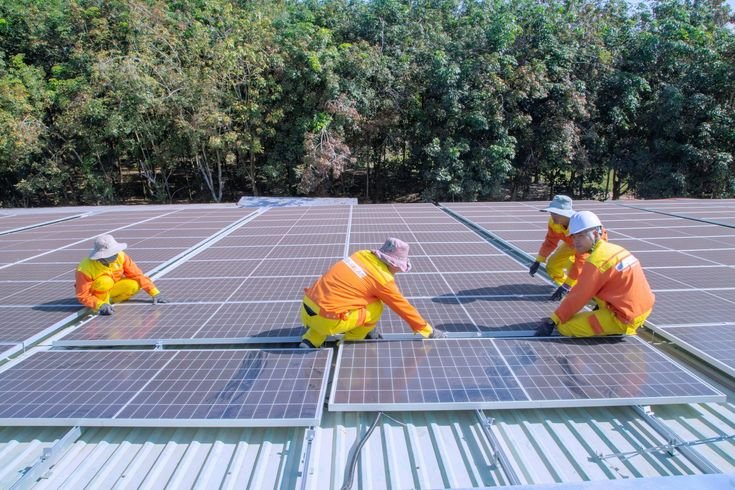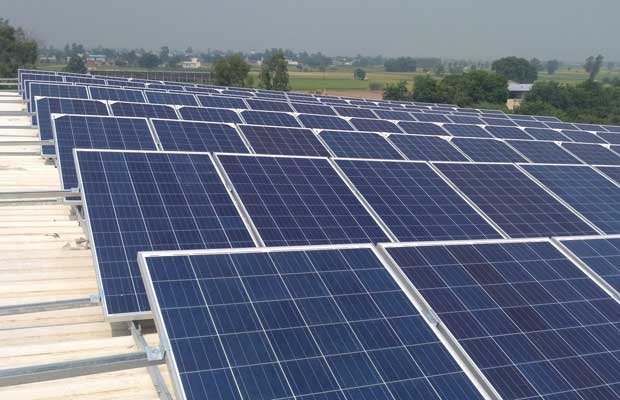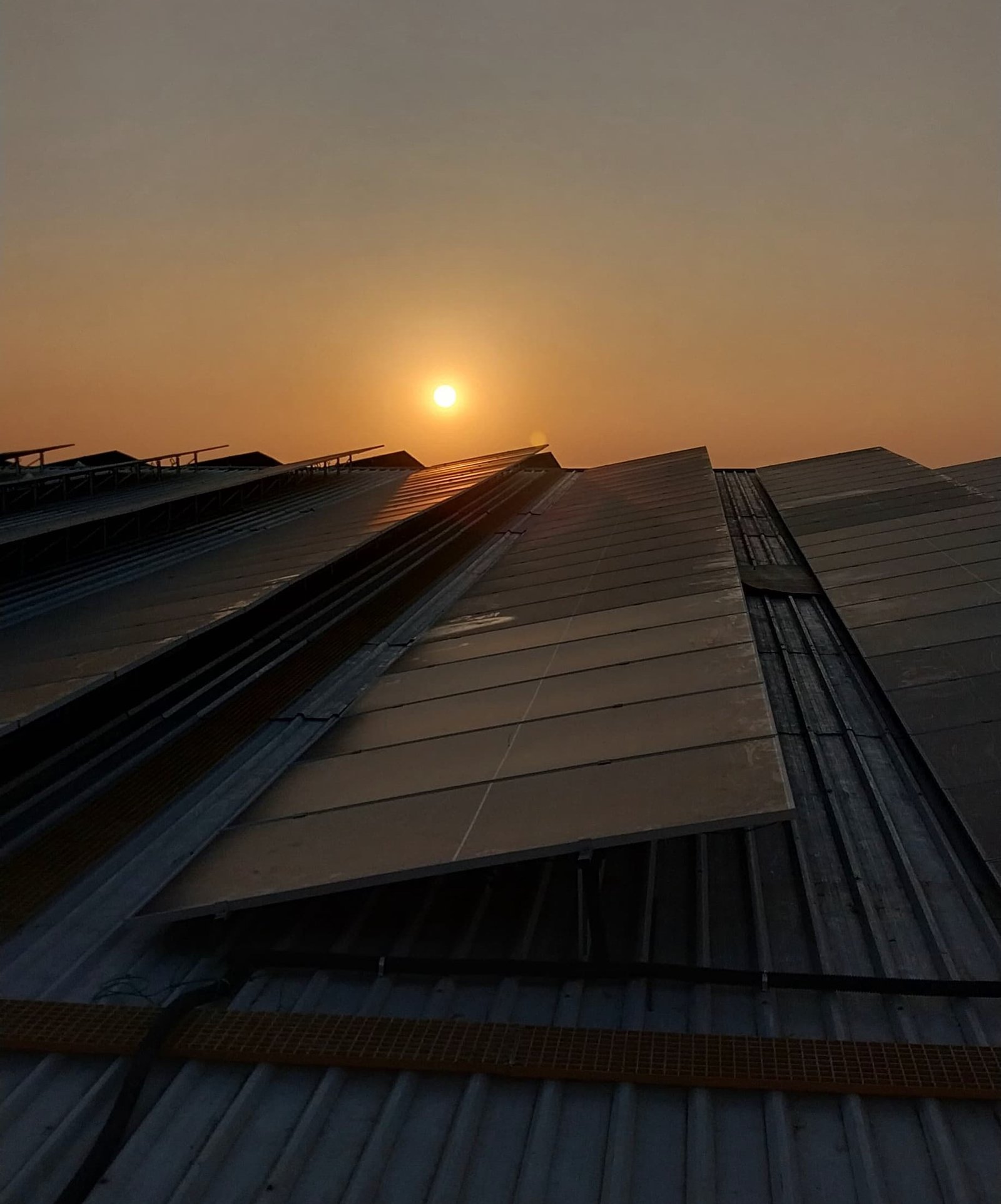The UK has been a trailblazer in adopting renewable energy sources, and solar power plays a pivotal role in this transformation. With the rising concerns about climate change and energy security, solar power plants in the UK are emerging as a key solution to meet the country’s energy needs sustainably. This comprehensive guide explores the state of solar power in the UK, its benefits, challenges, and the path forward.
Table of Contents
Introduction to Solar Power Plants in the UK
Solar power plants are large-scale facilities that harness sunlight to generate electricity. These plants use photovoltaic (PV) panels or solar thermal systems to convert sunlight into usable energy. The UK, despite its reputation for cloudy weather, has seen remarkable growth in solar energy adoption, thanks to technological advancements and government support.
At Soleos Solar, we are committed to driving the renewable energy revolution by delivering innovative and sustainable solar solutions. Our mission is to make solar power accessible and efficient for everyone in the UK and beyond.
Why Solar Power Plants in the UK Are Essential
1. Reducing Carbon Emissions
One of the most significant contributions of solar power plants is their role in mitigating climate change. By reducing reliance on fossil fuels, solar power plants are pivotal in decreasing greenhouse gas emissions.
Key Points:
- Zero Operational Emissions: Unlike coal or gas power plants, solar facilities produce electricity without releasing CO₂ or other pollutants.
- Offsetting Traditional Energy: Solar farms replace energy generated by fossil fuels, reducing the UK’s overall carbon footprint.
- Lifecycle Impact: Even when considering manufacturing and installation, solar panels have a much smaller environmental impact compared to non-renewable energy sources.
For instance, a 50 MW solar power plant in the UK can reduce carbon emissions by approximately 20,000 metric tons annually, equivalent to planting over 1 million trees.
2. Improving Energy Independence and Security
The UK faces challenges with energy security, especially as global energy markets fluctuate. Solar power plants help mitigate this by providing a reliable, domestically-produced energy source.
Key Points:
- Local Energy Production: Solar power reduces dependence on imported oil and gas, boosting energy independence.
- Stability in Supply: With energy storage systems, solar plants can provide a steady power supply, even during nighttime or cloudy days.
- Decentralized Generation: Distributed solar installations, combined with large-scale solar farms, lower the risks of energy disruption.
By 2030, it is estimated that renewable energy, led by solar, could meet 70% of the UK’s energy needs, ensuring resilience against geopolitical energy crises.
3. Driving Technological Advancements
Solar power plants in the UK are at the forefront of innovation, with cutting-edge technologies enhancing efficiency and reducing costs.
Key Innovations:
- Bifacial Panels: Capture sunlight on both sides for greater energy output.
- Energy Storage Solutions: Advanced batteries store surplus energy, ensuring grid reliability during low solar generation periods.
- Floating Solar Farms: Utilizing reservoirs and lakes, floating installations reduce land use conflicts and increase panel cooling efficiency.
- AI Integration: Artificial intelligence optimizes solar plant operations, predicts maintenance, and enhances grid integration.
These advancements are making solar power plants more efficient and cost-effective, solidifying their role in the renewable energy mix.
4. Fostering Economic Growth
The solar industry is a major driver of economic development in the UK. Solar power plants contribute to job creation, stimulate local economies, and attract investment.
Key Points:
- Job Creation: From research to installation and maintenance, the solar sector supports thousands of jobs across the UK.
- Community Benefits: Local businesses benefit from contracts related to solar farm development and operations.
- Investment Attraction: The UK’s solar energy market attracts both domestic and international investments, fostering economic resilience.
A single large-scale solar power plants project can inject millions of pounds into the local economy during its construction phase and beyond.
5. Supporting Sustainability Goals
Solar power plants align with the UK’s commitment to achieving net-zero emissions by 2050. They also contribute to the United Nations’ Sustainable Development Goals (SDGs).
Contributions to Sustainability:
- Goal 7 – Affordable and Clean Energy: Solar energy is a cost-effective renewable source, accessible to businesses and households.
- Goal 13 – Climate Action: Solar reduces greenhouse gas emissions and mitigates climate change.
- Biodiversity Protection: Solar farms, when designed thoughtfully, can enhance local ecosystems by creating habitats for pollinators and wildlife.
Projects like the Cleve Hill Solar Park demonstrate how renewable energy initiatives can balance environmental sustainability with energy generation.
6. Transforming the Energy Grid
As solar adoption grows, the UK’s energy grid is evolving to accommodate renewable sources. Solar power plants are a cornerstone of this transformation.
Key Points:
- Grid Modernization: Smart grids manage fluctuating energy inputs from solar and other renewables.
- Demand Response: Solar energy supports grid stability during peak demand periods, reducing strain on traditional power systems.
- Distributed Generation: Solar power decentralizes energy production, making the grid more resilient to disruptions.
Innovative projects integrating solar with other renewable sources, like wind and hydropower, are creating a robust, low-carbon energy infrastructure.

Components of a Solar Power Plants
A typical solar power plants in the UK comprises the following:
1. Solar Panels (Photovoltaic Modules): These panels are made up of photovoltaic (PV) cells, typically composed of semiconductor materials like silicon. They capture sunlight and convert it into direct current (DC) electricity.
2. Inverters: Since most electrical grids and appliances operate on alternating current (AC), inverters are essential to convert the DC electricity produced by the solar panels into AC electricity.
3. Mounting Systems (Racking and Mounts): These structures securely hold the solar panels in place, either on the ground or on rooftops, and are designed to optimize the angle and orientation of the panels for maximum sunlight exposure.
4. Electrical Components: This category includes various devices that ensure the safe and efficient operation of the solar power plants:
- AC and DC Isolators: These switches allow for the disconnection of the system from the grid or the panels for maintenance or emergency purposes.
- Generation Meters: These meters measure the amount of electricity generated by the solar panels.
- Cabling and Wiring: Proper electrical wiring is crucial for transmitting electricity from the panels to the inverters and then to the grid or storage systems.
5. Energy Storage Systems (Optional): Batteries can store excess electricity generated during sunny periods for use during times when sunlight is insufficient, enhancing the reliability and efficiency of the solar power plants.
6. Monitoring and Control Systems: These systems track the performance of the solar power plants, detect faults, and optimize operations to ensure maximum efficiency.
Types of Solar Power Plants in the UK
1. Photovoltaic (PV) Solar Power Plants
These facilities convert sunlight directly into electricity using photovoltaic cells. They are the most prevalent type in the UK and can be further classified into:
- Rooftop Solar Plants: Installed on residential, commercial, or industrial building rooftops, these systems provide electricity primarily for on-site use. They are common in urban areas where space is limited.
- Ground-Mounted Solar Plants: Situated on open land, these larger installations contribute significantly to the national grid. They are often referred to as solar farms and are typically located in rural areas.
- Floating Solar Plants: Also known as “floatovoltaics,” these systems are deployed on bodies of water such as reservoirs or lakes. While less common, they offer an innovative solution for space constraints and can reduce water evaporation.
2. Concentrated Solar Power (CSP) Plants
These plants use mirrors or lenses to concentrate sunlight onto a receiver, producing heat that generates electricity through a turbine. CSP plants are less common in the UK due to the country’s climate and lower direct sunlight levels.
3. On-Grid (Grid-Tied) Solar Systems
These systems are connected to the national grid, allowing excess electricity to be fed back into the grid. They are the most common type in the UK, enabling users to benefit from schemes like the Smart Export Guarantee (SEG).
4. Off-Grid Solar Systems
Independent of the national grid, these systems rely on batteries to store electricity for use when sunlight is unavailable. They are suitable for remote locations without grid access but are less common due to higher costs and maintenance requirements.
5. Hybrid Solar Systems
Combining on-grid and off-grid features, hybrid systems are connected to the grid but also include battery storage. This setup provides greater energy independence and reliability, allowing users to store excess energy for use during peak demand or outages.

Government Support and Incentives
The UK government has implemented several policies to promote solar energy:
- Smart Export Guarantee (SEG): Introduced in January 2020, the SEG requires licensed electricity suppliers to compensate small-scale renewable energy producers, including solar PV systems, for surplus electricity exported back to the grid. This scheme replaced the previous Feed-in Tariff (FiT) program and provides an ongoing financial return for solar energy generation.
- Zero VAT Rate: As of April 2022, the UK government has applied a 0% VAT rate on the installation of energy-saving materials, including solar panels and batteries, for residential properties. This reduction, effective until March 2027, lowers the upfront costs for homeowners investing in solar energy systems.
- Home Upgrade Grant (HUG): Available from September 2023 to March 2025, the HUG provides financial assistance to low-income households living in energy-inefficient homes (rated D to G). The grant supports various energy efficiency improvements, including the installation of solar panels, to reduce energy consumption and costs.
Challenges Facing Solar Power Plants in the UK
- Weather Variability: The UK’s unpredictable weather can impact solar energy production. However, modern technology mitigates this issue by improving panel efficiency.
- Land Availability: Utility-scale solar farms require significant land, leading to potential conflicts with agricultural and residential needs.
- Grid Integration: Solar energy’s variability poses difficulties for grid stability. Fluctuations in solar power generation require advanced grid management and energy storage solutions to maintain consistent electricity supply.
- Grid Capacity Constraints: The existing grid infrastructure may struggle to accommodate the increasing influx of solar-generated electricity, leading to potential bottlenecks and limiting the expansion of solar installations.
- Economic and Policy Uncertainties: Fluctuations in government policies, subsidies, and market conditions can create financial unpredictability for investors and developers in the solar sector.
Innovations in Solar Power Technology
The solar industry in the UK is witnessing rapid technological advancements, including:
- Perovskite Solar Cells: Researchers at the University of Oxford have been developing perovskite-based solar cells, which offer high efficiency and can be produced at lower costs compared to traditional silicon-based cells. These cells have the potential to significantly reduce the need for large solar farms by enabling integration into various surfaces.
- Graphene-Based Conductive Inks: GraphEnergyTech, a spin-out from the University of Cambridge, is developing conductive graphene inks to replace silver electrodes in solar panels. This innovation aims to reduce material costs and resource dependency, enhancing the sustainability and affordability of solar technology.
- Building-Integrated Photovoltaics (BIPV): Advancements in BIPV involve incorporating solar cells directly into building materials, such as windows and facades. This approach allows structures to generate electricity without the need for separate solar panels, promoting aesthetic integration and space efficiency.
- Solar-Powered Hydrogen Production: Innovations in solar reforming processes are enabling the conversion of sunlight into hydrogen fuel. This technology offers a sustainable method for producing hydrogen, which can be used as a clean energy source for various applications.
- Space-Based Solar Power: UK-based company Space Solar has entered into agreements to develop systems that collect solar energy in space and transmit it to Earth. This technology aims to provide continuous, low-carbon power by overcoming the intermittency issues associated with ground-based solar installations.
- Flexible and Thin-Film Solar Cells: Advancements in thin-film technology have led to the development of flexible solar cells that can be applied to a variety of surfaces, including curved and portable devices. These innovations expand the potential applications of solar energy beyond traditional installations.

Environmental Impact of Solar Power Plants
Solar power plants contribute significantly to environmental conservation by:
- Reduction in Carbon Footprint: Solar energy generation is a clean process that does not emit greenhouse gases during operation. Over their typical 30-year lifespan, solar panels provide zero-carbon electricity, contributing to the UK’s efforts to mitigate climate change.
- Decreased Air Pollution: By replacing fossil fuel-based energy sources, solar power reduces air pollutants, leading to improved public health and environmental quality.
- Biodiversity Enhancement: Implementing higher biodiversity net gain (BNG) requirements for renewable energy projects can improve natural habitats. For instance, increasing the BNG requirement to at least 100% is suggested to maximize biodiversity benefits, reinforcing the UK’s leadership in climate action, and enhancing local communities’ access to nature.
- Sustainable Siting and Design: Careful selection of sites and thoughtful design can minimize land use conflicts and habitat disruption. Utilizing previously developed land or integrating solar panels into buildings can reduce the need for greenfield development.
- Advancements in Recycling: Developing efficient recycling technologies and establishing robust end-of-life management policies can address concerns related to the disposal of solar panels.
Future Prospects
The future of solar power in the UK looks bright, with ongoing investments and innovations paving the way for greater adoption. The UK’s commitment to renewable energy and technological advancements will ensure that solar power remains a cornerstone of the country’s energy strategy.
Conclusion
Solar power plants are not just a renewable energy solution; they are revolutionizing the UK’s energy landscape. From reducing carbon emissions and enhancing energy security to driving technological innovation and economic growth, the impact of solar energy is transformative.
At Soleos Solar, we are proud to contribute to this renewable energy revolution. Our cutting-edge solar solutions empower individuals, businesses, and communities to harness the sun’s power for a sustainable future.
If you’re ready to join the solar revolution, contact us today and discover how we can help you make a lasting impact.
